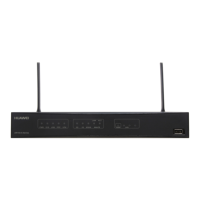It is recommended to automatically generate a link-local address because the link-local address
is used only for the communication between link-local nodes. Commonly, it is used to implement
communication requirements of protocol and is not directly related to the communication
between users.
The global unicast address is equivalent to the IPv4 public address. It is used for data forwarding
across the pubic network, which is necessary for the communication between users.
An EUI-64 address has the same function as an global unicast address. The difference is that
only the network bits need to be specified for the EUI-64 address and the host bits are transformed
from the MAC addresses of the interface while a complete 128-bit address need to be specified
for the global unicast address. Note that the prefix length of the network bits in an EUI-64 address
must not be longer than 64 bits.
The EUI-64 address and the global unicast address can be configured simultaneously or
alternatively. However, the IP addresses configured for one interface cannot be in the same
network segment.
Pre-configuration Tasks
Before configuring IPv6 addresses, complete the following tasks:
l Configuring the physical features of the interface and ensuring that the status of the physical
layer of the interface is Up
l Configuring the link layer parameters for the interface and ensuring that the status of the
link layer protocol on the interface is Up
Data Preparation
To configure IPv6 addresses for an interface, you need the following data.
No.
Data
1 Number of the interface
2 Link-local address configured manually
3 Global unicast address and prefix length
3.3.2 Enabling IPv6 Packet Forwarding Capability
You can perform other IPv6 configurations on an interface only when IPv6 is enabled in the
interface view. To enable IPv6 packet forwarding on an interface, you must configure IPv6 in
the system view.
Context
To enable a device to forward IPv6 packets, you must enable the IPv6 capability in both the
system view and the interface view. This is because:
l If you run the ipv6 command only in the system view, only the IPv6 packet forwarding
capability is enabled on a device. The IPv6 function, however, is not enabled on the interface
and hence you cannot perform any IPv6 configurations.
Huawei AR150&200 Series Enterprise Routers
Configuration Guide - IP Service 3 Basic IPv6 Configuration
Issue 02 (2012-03-30) Huawei Proprietary and Confidential
Copyright © Huawei Technologies Co., Ltd.
55

